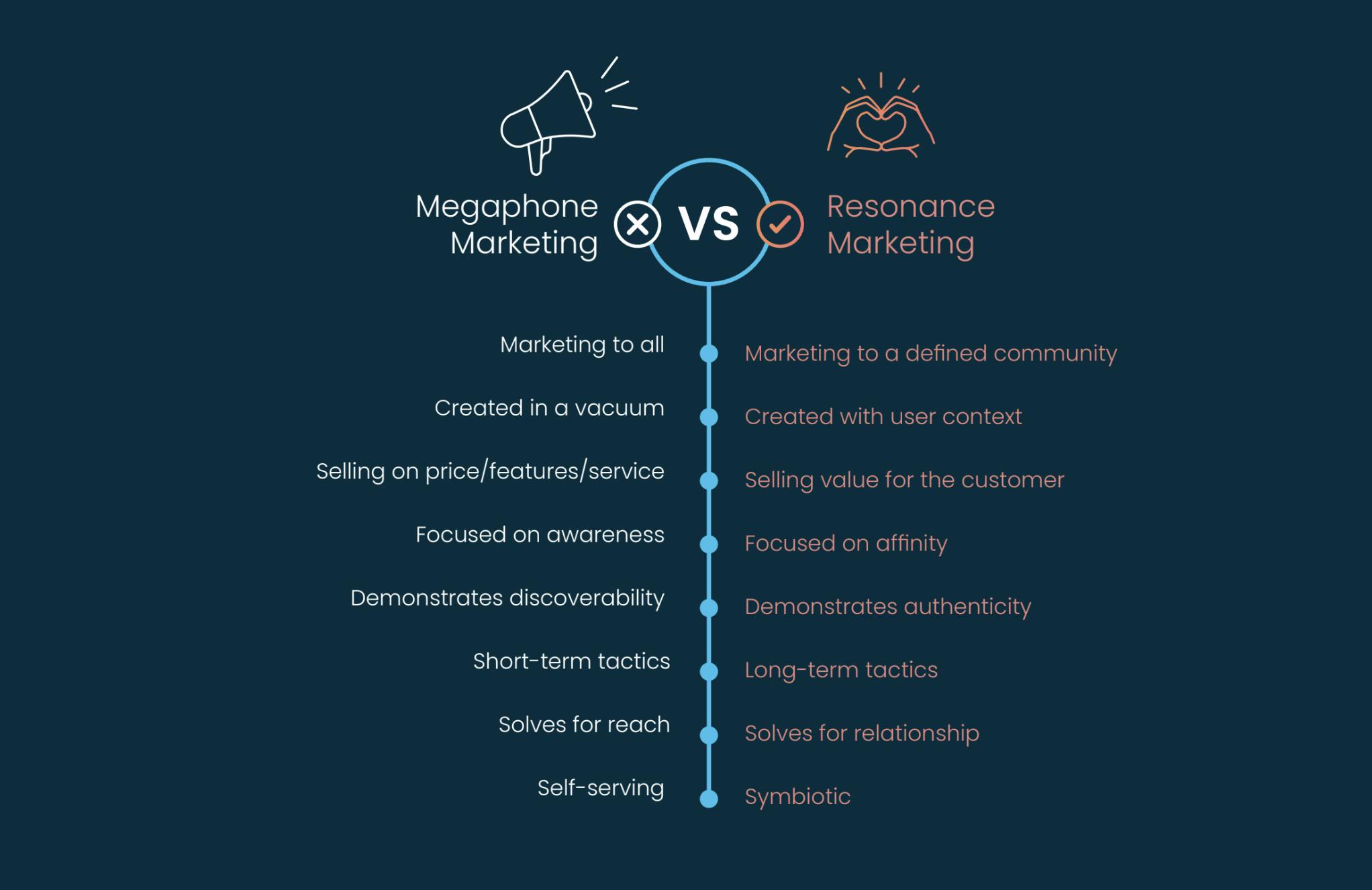Megaphone marketing vs. resonance marketing

Is your marketing breaking through the noise or adding to it?
The following is based on an excerpt from our latest eBook. Download the full version here.
Have you ever been approached by a salesperson who launched right into a spiel, barely coming up for air, pitching something that was not even relevant to you in the first place? Chances are, that conversation did not last long and that salesperson did not convince you to take action.
Hopefully, you are not yelling at your customers to get their attention, but this approach is illustrative of a common trap that organizations can fall into, especially when marketing budgets are prematurely slashed. When marketers are under pressure to pursue short-term key performance indicators (KPIs) like impressions or clicks, it’s easy to dehumanize the person at the end of the transaction, and think of them as a number, a “lead,” or a “target.”
Traditionally, marketing’s role has been to push offers repetitively until consumers take action, measuring advertising’s “effective frequency” — or the number of exposures until conversion. The “rule of seven” is a common mantra — prospects need to see an ad seven times before they’re compelled to take action.
While consumers need to be aware of what you’re offering, to convert, they need to care about it. This is the main difference between “megaphone marketing” (also known as “spray and pray”) and resonance marketing. While megaphone-style marketing blasts to a broad audience, resonance marketing engages priority buyers and turns them into superfans.
What is resonance marketing?
While “brand resonance” is a familiar marketing term, referring to the emotional connection between brands and consumers (Keller, 1993), resonance marketing (as we at Modus define it) is a method of engaging with an audience in ways that make them feel compelled to amplify your message and advocate for your brand. To achieve resonance marketing requires design thinking — human-centered solutions are created with an understanding of the customer’s goals, behaviors, and points of view.
Resonance marketing is respectful. At the end of the connection is a person trying to solve problems. Rather than push a passive sales experience (i.e., being sold to), resonance marketing taps into empathy and insight to inspire action.
Megaphone marketing vs. resonance marketing

Of course, megaphone marketing isn’t necessarily a bad tactic. If you’re launching a new business, you need to prioritize reach. For example, a SaaS product may promote a large number of free trials to a wide demographic. Once new prospects convert and become customers, your company has a chance to dial in a more meaningful and resonant approach.
And in times of economic uncertainty, some buyers will be sensitive to pricing, and a coupon may be just the ticket to get them in the door. Your audience may not have the budget to purchase your topline offerings today, but if they recognize the personal value your brand can bring them — your brand equity — they will think of you when that budget reappears.
The case for resonant marketing
In the B2B world, researchers from the Ehrenberg-Bass Institute found that 95 percent of intended buyers are not even in the market for products or services in any particular quarter. Meanwhile, 92 percent of B2B marketing budgets are spent on short-term, bottom-funnel objectives like lead generation. Only 8 percent focus on long-term brand awareness.
A 2021 Nielsen study, commissioned by Google, showed that brands that added upper-funnel, brand awareness marketing efforts to existing mid-funnel campaigns were able to boost ROI by 70 percent. And those that added upper-funnel tactics to campaigns that covered the mid and lower funnel were able to boost ROI by 13 percent.
When consumers are ready to buy, they’ll already be familiar with and want to know more about your business.
The opportunity resonance marketing offers forward-thinking marketers is to impact their audience with salient, memory-building communications. This way, when consumers are ready to buy, they’ll already be familiar with and want to know more about your business.
While there’s no magic bullet for creating a resonant marketing strategy, we at Modus have a framework we utilize with clients to help them understand their audience’s mindset on a deeper level so that they can provide them with memorable communications. And because consumer preferences are constantly shifting, it’s vital that marketers use a design-thinking lens to continuously adapt their strategies to appeal to customers and establish long-term brand loyalty.

